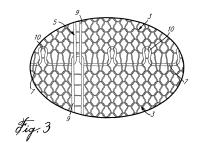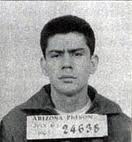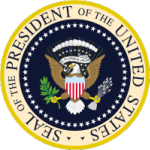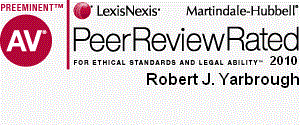Newsletter Issue 40 - June 2012
In this issue:
Patenting the non-obvious problem
Self-incrimination - It's for everybody.
Trade Dress
IP protection around the world.
An Obvious Solution to a Non-Obvious Problem
Inventors and patent attorneys know that creating any invention has two parts: (a) identifying a problem; and (b), solving that problem. To protect the invention by patent, the invention must be 'non-obvious.' That is, if two or more prior art patents or other references when taken together teach all of the elements of a patent claim and it is reasonable to combine those elements, then the claim is obvious and not patentable. The 'non-obviousness' requirement is usually the most difficult hurdle for an inventor to cross in obtaining or defending a patent.
Every invention is obvious in 'hindsight;' that is, based on the knowledge revealed in the patent application or subsequent to the application. To avoid 'hindsight,' judges and patent examiners are supposed to consider the state of the art at the time the application was filed, not the state of the art at the time the judge or examiner is deciding the question.
The Federal Circuit Court of Appeals recognized in the recent case of Mintz v Dietz and Watson that if either (a) the problem or (b) the solution is non-obvious, then the invention meets the non-obvious requirement for patentability. Mintz invented a casing to hold a processed meat while allowing the meat to bulge between net strands, avoiding older knitted meat casements. In an infringement and declaratory judgment action, the trial court found Mintz's patent on the casing to be obvious and hence invalid. The trial court relied on Mintz's statement of the problem in the patent application and concluded that Mintz's invention was an obvious solution to the problem.
The Federal Circuit Court reversed the trial court, holding that the trial court could not look to the patent to define the problem - that was prohibited hindsight. The Federal Circuit held that an obvious solution to the non-obvious problem identified by Mintz was non-obvious and hence patentable.
You Have the Right to Remain Silent...
The 1966 landmark Supreme Court case of Miranda v. Arizona gave us that famous TV cop phrase, "You have the right to remain silent..." This warning, called the Miranda Warning after the name of the criminal defendant in the case, whose mug shot appears at right, is so common that many citizens can almost repeat it by heart. The holding of that famous case is that when a person is placed in custody by law enforcement officers, they must inform the person of the Constitutional right against self-incrimination and the right to counsel. And this warning must be understood by the person in custody. So far, so good.
In 2010, the Supreme Court ruled in Berghuis v. Thompkins that a person cannot just remain silent, but that, paradoxically, in order to invoke the right to remain silent, the person in custody has to unambiguously state that he or she wishes to remain silent.
But what if you are not in custody, but you are being spoken to by an employee of a government agency? What are your rights, and what should you do?
A troubling trend in recent years has been for the Federal Government to prosecute under the provisions of 18 U.S.C. § 1001, which prohibits lying to or concealing information from a federal official. That law provides, in part:
(a) Except as otherwise provided in this section, whoever, in any matter within the jurisdiction of the executive, legislative, or judicial branch of the Government of the United States, knowingly and willfully (1) falsifies, conceals, or covers up by any trick, scheme, or device a material fact; (2) makes any materially false, fictitious, or fraudulent statement or representation; or (3) makes or uses any false writing or document knowing the same to contain any materially false, fictitious, or fraudulent statement or entry; shall be fined under this title, imprisoned not more than 5 years...
Nobody is required to read you your rights when you're not in custody. That's because this crime -- lying to the government -- has not yet been committed. When that official starts asking you questions, you may not be in trouble - yet.
In recent years, this provision has been used to prosecute an increasing number of cases, some having only a distant relation to federal crimes. In one case, an Idaho farmer, Cory King, was convicted of lying to a state livestock inspector about where a valve on the property sent some water. Mr. King allegedly said the valve routed the water to a sprinkler system when in fact it sent water to a well. Idaho didn't pursue criminal charges, but the federal government did, under Section 1001. Mr. King's statement was made to a state official, but the Justice Department argued that lying to the state inspector interfered with enforcement of federal drinking-water laws. The false statement "need not be made directly" to the federal government, said one Justice Department court filing.
In the same way that Gangster Al Capone was eventually jailed on charges of tax evasion ("Selected Documents: Jury Verdict Form (October 17, 1931)"), rather than, say, machine-gunning his rivals, the government convicted Martha Stewart of, among other offenses, lying to securities investigators, rather than of insider trading in her sale of 4,000 shares of ImClone stock to avoid a loss of about $46,000 ("Stewart Convicted on All Charges," CNN, March 5, 2004).
So what is the law-abiding citizen to do? How are we to know when a simple misstatement of fact will be the basis for a full-blown federal prosecution, potentially costing years and hundreds of thousands of dollars in legal fees? The simple answer is that for a small but still significant number of citizens who have spoken to federal, state and local officials about everything from photographing migrating whales to valves on pipes, there was no way to tell. When a government official shows up at your door and starts asking questions, you will have no way to tell. While we would not go so far as to recommend that our clients never speak to government officials, we counsel caution when doing so. After all, pausing to talk to your attorney may give a bit of time to consider what is being asked of you, and the answer you want to give. If there is any doubt, attorneys may always ask officials for limited immunity, and obtaining that may prevent a simple mistake of fact from becoming a felony conviction later on.
In Brogan v. US, Justice Ruth Bader Ginsburg worried about "the extraordinary authority Congress, perhaps unwittingly, has conferred on prosecutors to manufacture crimes" out of false statements. Mr. King, that Idaho farmer, knows that she was right to be worried.
Trade Dress: Protecting the Design, Look and Feel of a
Product
Trademarks provide important intellectual property protection to businesses and to their products. Trademarks identify the source or origin of goods or services. A related sub-concept of trademarks that also provides broad intellectual property protection to a business is the concept of trade dress.
Trade dress protects a product's unique design, look and feel. It covers the overall image generated by the product or package. Trade dress comprises traits such as shape, package, size, color, color combination, texture, and graphics. In general, trade dress protects the image of a product. For example, a bucket full of chicken is the trade dress for KFC, the sensual shape of a Coca-Cola bottle is the trade dress of the trademark Coca-Cola, a sophisticated blue box is the trade dress of Tiffany, a yellow and red color combination package is the trade dress of Kodak films.
Trade dress protection may also be available for products, packaging, or business forms and stationery for which a design patent, utility patent or copyright protection may not be available after its expiration. If these other types of protection were never obtained, then trade dress rights may nonetheless be available. For example, it is possible to concurrently protect a design with both trade dress rights and a design patent. Also, trade dress protection is available to protect a design after a design patent has expired.
To obtain trade dress protection for product configurations, it is required to show that the design of the product at issue is inherently distinctive, or has acquired secondary meaning. However, trade dress protection cannot be obtained for a product functional in nature if the product is utility patent protected. Furthermore, to obtain protection of a product under trade dress, the concept protected must be non-functional in nature. For example, if a disputed product configuration is part of a claim in a utility patent, and the configuration is descriptive of the inventive concept, then the doctrine of trade dress which is necessarily functional in nature is not available until the patent for that product has expired and has entered the public domain.
In one of the most important trade dress cases to date, the Supreme Court, in Two Pesos, Inc. v. Taco Cabana, Inc.,(505 U.S. 763, 112 S.Ct. 2753 (1992), held protectable the trade dress of Taco Cabana's restaurant, and described it as "a festive eating atmosphere having interior dining and patio areas decorated with artifacts, bright colors, paintings and murals. The patio includes interior and exterior areas with the interior patio capable of being sealed off from the outside patio by overhead doors; the stepped exterior of the building is a festive and vivid color scheme using top border paint and neon stripes. Bright awnings and umbrellas continue the theme".
For a more detailed article on trade dress, follow this link.
2012 Special 301 Report Outlines Intellectual Property Rights -- Gains and Losses
In April 2012, the The Office of the United States Trade Representative (USTR) issued its "2012 Special 301 Report" (Report) in which it reviews the state of intellectual property rights protection and enforcement in trading partners around the world. It's an interesting document, which underscores the importance of intellectual property rights (IPR) to world economy, the need to protect those rights, and the need for IPR holders to be constantly vigilant. Here are some highlights.
Positive developments in IP are reported for Malaysia, Spain, Israel, Russia, and, yes, China. Malaysia passed copyright amendments that prevent the circumvention of technological protection measures; establish a mechanism for cooperation by Internet service providers against piracy over the Internet; and prohibit the unauthorized camcording of motion pictures in theaters. Having enacted new laws against Internet copyright piracy, the United States has removed Spain from its IP Watch List. The Report also notes that Israel has enacted a new law protecting against unfair commercial use and that Russia has passed a law that establishes a specialized IPR court and amended its Criminal Code to revise criminal thresholds for copyright piracy.
China has recently established a State Council-level leadership structure, headed by Vice Premier Wang Qishan, to lead and coordinate IPR enforcement across China. This leadership structure is meant to enhance China's ability to address IPR infringement. Interestingly, the performance of provincial level officials will be measured based on enforcement of IPR in their regions.
USTR also describes various international initiatives to strengthen IPR protection and enforcement. These include a Trans-Pacific Partnership with Australia, Brunei Darussalam, Chile, Malaysia, New Zealand, Peru, Singapore, and Vietnam with the goal of creating a platform for integration across the region that will include strong standards for the protection and enforcement of IPR.
Australia, Canada, the European Union, Japan, Korea, Morocco, New Zealand, and Singapore, along with the United States, signed Anti-Counterfeiting Trade Agreement (ACTA) for fighting trademark counterfeiting and copyright piracy.
The United States is also working with trading partners to strengthen IPR protection and enforcement through bilateral and regional agreements, including free trade agreements. In addition, Trade and Investment Framework Agreements between the United States and various trading partners have facilitated discussions on enhancing IPR protection and enforcement. The Report goes on to describe other international initiatives. In one instance it states:
As an example of an outcome of such engagement, in November 2011, APEC Ministers endorsed the APEC Effective Practices for Addressing Unauthorized Camcording, which will assist APEC economies to implement public awareness efforts, engage in cooperation with the private sector on capacity building, and adopt effective legal frameworks to address the challenges of unauthorized camcording in cinemas.
The majority of the USTR report explains developments and changes in the so-called "Priority Watch" and "Watch" lists. USTR created the Watch List to name countries where particular problems exist with respect to IPR protection, enforcement, or market access for persons relying on IPR. Countries placed on the Priority Watch List are the focus of increased bilateral attention concerning the problem areas.
Countries named on the Watch List include Belarus, Bolivia, Brazil, Brunei Darussalam, Colombia, Costa Rica, Dominican Republic, Ecuador, Egypt, Finland, Greece, Guatemala, Italy, Jamaica, Kuwait, Lebanon, Mexico, Norway, Peru, Philippines, Romania, Tajikistan, Turkey, Turkmenistan, Uzbekistan, and Vietnam.
Those name to the Priority Watch List are Algeria, Argentina, Canada, Chile, China, India, Indonesia, Israel, Pakistan, Russia, Thailand, Ukraine, Venezuela. You might be surprised by the appearance of Canada, which appears primarily because of the country's failure to enact comprehensive copyright legislation and strengthen its boarder enforcement efforts.

